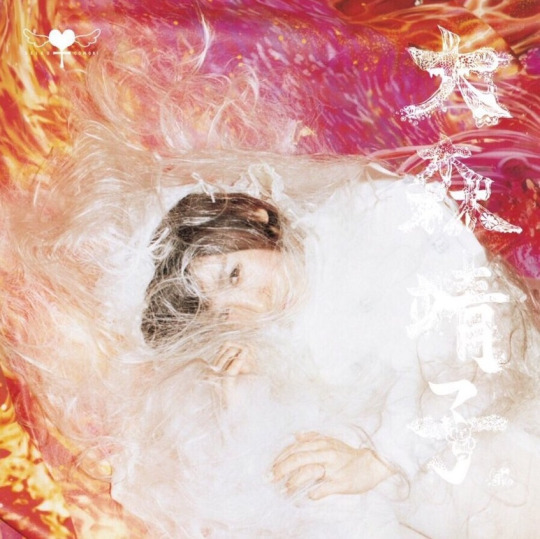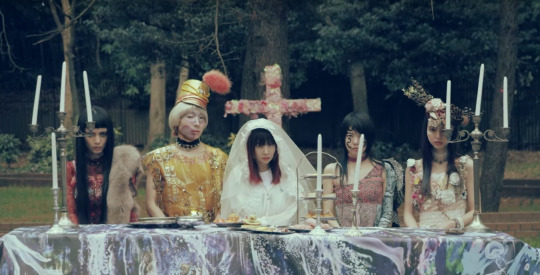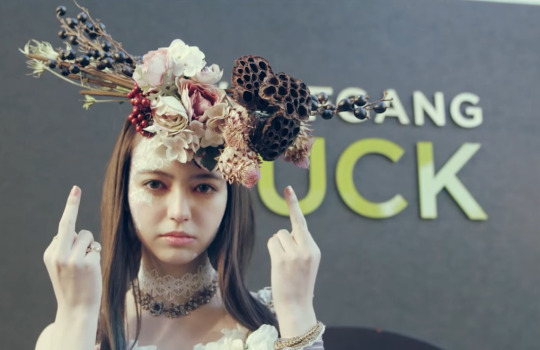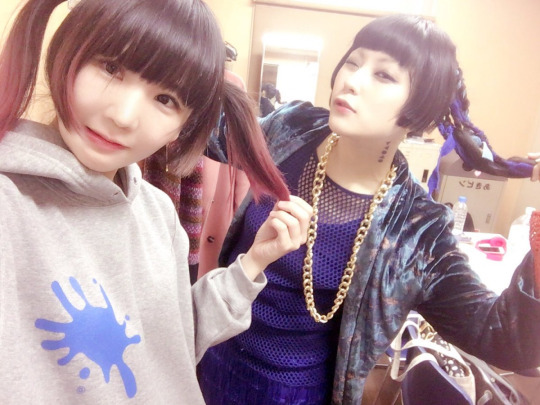#FORCING children to experience SENSORY OVERLOAD /j
Explore tagged Tumblr posts
Text

what fresh hell is this in my recommendations
#FORCING children to experience SENSORY OVERLOAD /j#to be fair. i saw the video and its educational! and its fairly accurate so yknow ill give them that#my only gripe is of course the autism tm simulation which i think is blown out of proportion to be dramatic (aka so nts actually care)#shitpost
4 notes
·
View notes
Text
Seiko Oomori - kitixxxgaia - Review
If you’ve read this blog before, you probably have a pretty good idea of my completely unbiased admiration for Seiko Oomori and everything she does. “Unbiased”.
So let’s just get to it. Less than a year, by about two weeks maybe to be precise, Seiko Oomori follows up her critically acclaimed major sophomore album (fourth overall) TOKYO BLACK HOLE with something even bigger, even more political, even more honest, and even more ambitious. I’m going to start off by changing my previous opinion. TOKYO BLACK HOLE is like an 8.5 now. Stay with me, here now and buckle up; we’re going for a ride, my friends.

The same week the United States got unleashed with the marvel of Drake’s More Life – a notably emotional return to form that also doesn’t shy away too far from the newer territory Toronto’s first celebratory hero has been invading – Japan was hit with something similarly parallel. Seiko Oomori gave us her fifth album kitixxxgaia on March 15th. Just like Drizzy, Seiko has given us an equally emotional experience, that still covers her recent sounds while almost giving us a slight return to her punk roots save for the general lack of an obvious acoustic guitar in most of the mixes (though it’s worth noting that it’s still there, just buried in the mix; I’ll get to why such a jam-packed mix actually works in a minute).

It’s amazing to see that the west and the east were both delivered promising projects by two of their biggest masters of music and emotion. It’s amazing to see just how far some shitty kid from Koenji has come in just five years since her official debut PINK in 2012. It’s amazing to think that that’s six albums if you count PINK, seven if you count the mostly self-covering Pink Tokarev album of 2015, which was otherwise an off-year for everyone’s favorite singer to imitate.
The only word I can describe how kitixxxgaia sounds with is “big”. And several other adjectives. Maybe “gigantic”. Maybe “colossal”. It’s a fucking huge album, pardon my French. This is potentially Seiko’s first Ringo Sheena-level album (let’s just forget that SUNNY happened for a minute). There’s a lot of religious imagery and a heavy aesthetic. I’d highly suggest on your first listen, you watch the music videos for every song that has one. So start with the “Dogma Magma” video, then the “Hikokuminteki Hero” video, listen to “IDOL SONG” normally, then when “Gutto Kuru Summer” comes along, watch that video too. And so on.

kitixxxgaia is heavy in its use of a very specific aesthetic, which takes influence from Christianity (and a hint of Mexican-style Christianity at that), weddings, quite a bit of Dadaism, and it’s all absolutely drenched in shades of pink and lighter blues. It’s the kind of album that’s best to be experienced both by listening and watching, as I said before. There are heaps of promotional images that came along with the album and the original “holy trinity” singles that lead up to its release, and I’d suggest maybe even just looking through those around Twitter and wherever else you can find them (maybe I’ll compile what I can find and make a post later this week) while you listen to the songs that aren’t accompanied by music videos. It’s the kind of multi-media work that could induce a sensory-overload in someone with synesthesia, like myself.

Now before I even get into the music of it, I want to point out the name of the album itself. Just the name kitixxxgaia (say it in English how you want, I generally say “Kitty Gaia”), much like her lyrics, takes some wordplay. In Japanese, the word “kichigai” - short for “[anta no] ki ga chigaimasu”, though nobody would ever say it that formally - is essentially the closest the Japanese language can get to the level of offense that words like (cover your children’s eyes) “fuck” or “cunt”. It doesn’t mean the same thing, but it’s that sort of level of offense, though deeper seeing as Japan is culturally much more introverted than we are over here.
Kichigai could loosely be translated to “you’re fucking crazy, man; you’re out of your goddamn mind.” Not in like a “woah dude that’s a fucking siiiick tattoo of a wolf” kind of way, though. It’s an insult, not a term of endearment. Adding the “a” to the end, Seiko turns it into “kichigaia” (キチガイア). After a day or two, she officially changed the name to romaji, now calling it “kitixxxgaia”, censoring it (possibly for management, cultural, and radio airplay reasons, but we don’t know specifically) by making it English and with three x’s in the middle. This name, to me, holds two simultaneous meanings, again, much like her signature style of lyricism.
The “kiti” could be interpreted as “kitschy”, a word referring to style in poor taste, much like our girl Seiko’s aesthetic. The word “gaia” is the personification of our planet Earth in ancient Greek texts. So it’s a “Kitschy World”.
“kitixxxgaia” in its original meaning, “Crazy Fucking World”.
Now to the music: Seiko has never let us down with a strong opener, and this might be the most in-your-face, unexpected opener, titled “Dogma Magma”. “Come on up to the emotional stage!” she blurts out before a gong bangs in your face; the remainder of the measure in silence before another hits with a choir on top, just underneath a piano playing downward arpeggios, and below that, some intricate string work, each instrument holding its breath. After the four bar intro, we crescendo up to the main song. Enter a not-quite shibuya-kei type beat – syncopated and staccato-like drums underneath a jittery, major piano progression. Behind it all is Seiko’s voice distorted, seemingly having a conversation with God.
As the filter cuts off, Seiko enters with some of her most provoking, forward lyrics ever written: (rough translation by yours truly): "Once upon a time there was something other than [just] male and female. Once upon a time there was something other than [just] white, black, and yellow [people]. Once upon a time there was something other than [just] yes and no. These things had always always existed, but it was then instead decided that they didn’t [exist].” she sings, touching on the recently hot topics of gender, race, and consent.

She continues “When I opened my eyes I was Japanese. I’m a goddess but I’m too uncomfortable in this inconvenient body to go outside without makeup on.”, a clear reference to body positivity clashing with self-esteem issues, and likely even cultural pressure in Japanese society. “Dogma Magma” has cuts into a more punk style chorus, reminiscent of “Magic Mirror”. “What will you do during the revolution? Just one heart? Fuck you, fuck [you] all, because this is war!” There she is. That’s the Seiko we know and love.

Track three is of note because it sort of takes me back to when she used to advertise herself as an idol during the Zettai Shoujo era for extra shock value. A clever parody on idol music and culture, “IDOL SONG” could almost pass off as a generic denpa song à la Band Ja Naimon!.
“JI・MO・TO no Kao Kawaii Tomodachi” (roughly “JI・MO・TO’s Cute-Faced Friend”) is certainly one of her most out-there songs, with a catchy, sugary hook, an almost rap verse not too different from what she did with “Zettai Kanojo”. It’s light, it’s bouncy, and it’s really good. This whole album is really good. Good. Good. Good. Good. It’s good music (Cruel Winter, when? I need answers, Kanye!).

Speaking of rapping, two songs later, Seiko gives us the ultimate collab for this generation of J-pop. Much like Ringo Sheena and Utada Hikaru’s “Nijikan Dake no Vacation” (roughly “A Vacation For Just The Two Of Us”), “Chikyuu Saigo no Futari” (roughly: “The Last Two People on Earth”) opens up eerily, with a huge texture and an oozing sub bass that launches into this groovy, dark, rhythmic masterpiece. Seiko begins “Dora-chan, warmest welcome to the 21st century, where mass production has made humans more like robots. Justice is brought by violence, the death penalty is given immediately unless you’re cute.” Seiko is soon interrupted: “I’m being forced to be stupid, these frames in front of me are out of my league. Fuck you, guidance! In my head, I’m punk.” Is that voice DAOKO? You bet your ass it is, and she is spitting that truth all over this track.

God there’s so much more to cover for this album but I really don’t want to ruin too much of it by blabbing on. Up next, continuing with the album’s religious themes “Pink Methuselah” brings a familiar sound with a twist – once it kicks in, it’s very clearly Kenta Sakurai (ex. Izukoneko, current Maison Book Girl, TOKYO BLACK HOLE’s “SHINPIN” producer) behind the producer’s chair on this one, but unlike “SHINPIN” from Seiko’s previous album, it’s not just another Sakurai song. It’s very clear how much Seiko added on top of what he did, and it’s like the perfect blend of both of their signature styles.

The album also features a menacing, full-piano self-cover of °C-ute’s “Mugen Climax”, a song that Seiko wrote for the extremely popular Hello! Project group. Now, she’ll never avoid Ringo Sheena comparisons – after all, Oomori’s debut album Mahou Ga…’s artwork pays direct tribute to Sheena’s legendary 2000 album Shouso Strip’s artwork - but what hearing this self-cover (which makes °C-ute’s version almost unlistenable) makes me want is a self-cover album from Seiko once she garners enough writing credits, much like Ringo Sheena’s Utaite Myouri.
The thing here about kitixxxgaia is that the album finishes off differently depending on the version you have. There are three versions: Dogma, Karma, and Gaia. Every version comes with a second “disc” that’s a DVD/Blu Ray; Dogma comes with a live Blu Ray of ZEPP Tokyo stop of the Tokyo Black Hole Tour, Gaia comes with live audio of that same show as well as a DVD of all of the album’s music videos, and Karma comes with a live DVD of a few different shows from last year. Each version also has a key difference to the main album – the final track is different.

As my personal recommendation, Dogma is the ideal version. Karma and Gaia finish off with new songs, but Dogma closes out with an acoustic re-recording of the Zettai Shoujo single “Kimi to Eiga” (literally: “Movie With You”). Since the closest thing we get to ‘acoustic’ on kitixxxgaia is “Mugen Climax” and “Orion Za”, this is a necessity to the album’s closure and really puts into perspective just how far Seiko has come since her humble beginnings.

The Karma song is called “Ramen no Hanashi” (literally “Ramen Conversation”) and the Gaia song is called “M”. “M” is another piano song, cutting in at just over 6 minutes. “Ramen no Hanashi” also does a similar job to “Kimi to Eiga”, being a full-acoustic track, and it’s a bonus that it’s a new song as well, so if you’re looking for a fully new experience or you’re not familiar with the Zettai Shoujo classic, maybe the Karma version is more for you. Either way, it’s a really nice way to end the album with some retrospect.

IDOL iS NOT DEAD gives kitixxxgaia a perfect 10/10. 11/10. Screw it. Whatever. It’s so goddamn good, just stop reading and go listen oh my god
14 notes
·
View notes